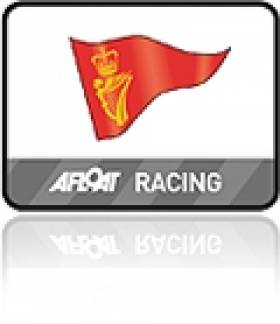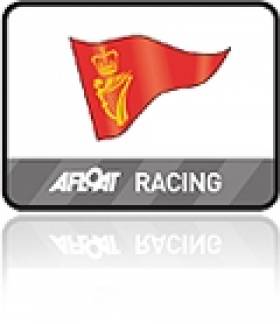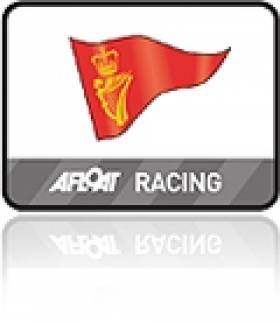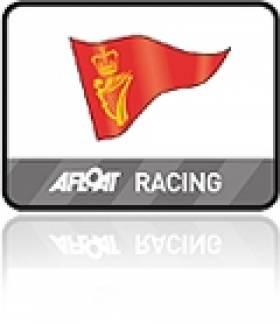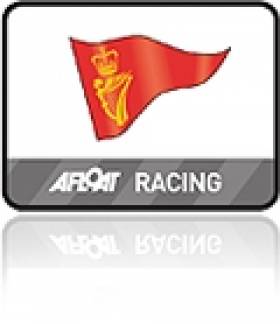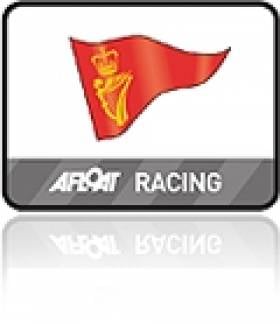Displaying items by tag: Royal Cork Yacht Club
Cork Harbour Combined League Launched for 2013 Sailing Season
#corkharbour – With the aim of providing better racing for Cork harbour class three yachts, a new harbour intiative this season attempts to combine up to 30 yachts currently split between different clubs and courses, namely Royal Cork Yacht Club and Cove Sailing Club.
There will be two races held each month between the months of May and September inclusive (Dates and organisng club below),
There is currently between 20 and 30 class three boats racing every week in cork harbour, but unfortunately they are split between different race courses and clubs.
With the combined league organiser Kieran O'Connell says they will be creating a common ground for all to meet up and 'truly explore the potential that class three has in Cork harbour'.
There will be a prize giving dinner in November.
All boats wishing to get involved in this league please contact Kieran O'Connell via the PDF flyer downloadable below. Closing date for entries is May 10th 2013.
Dates and Organising Club
May 10th Friday night Cobh
May 30th Thursday night RCYC
June 7th Friday night Cobh
June 21st Mid Summer Madness RCYC
July 14th Scora Chps Cobh
July 27th Race to Aghada RCYC
Aug 18th Cobh Peoples Regatta Cobh
Aug 29th Thursday night RCYC
Sept 7th Cobh to Blackrook Cobh
Sept 14th Naval Race RCYC
Cork Team Invited to Sail Again at New York Yacht Club
#rcyc – Regular Irish participant Royal Cork Yacht Club is returning to New York Yacht Club for International corinthian competition this September.
From the first edition in 2009, the resounding success of the New York Yacht Club Invitational Cup presented by Rolex reignited the tradition of international Corinthian competition between yacht clubs. The biennial event - returning to Newport from September 7-14, 2013 - fuses five days of intense racing with a glamorous social schedule to deliver an unrivaled event for competitors from around the globe.
The 20 yacht club teams will race one-design NYYC Swan 42s - identically tuned and equipped with supplied sails - on Narragansett Bay and Rhode Island Sound, one of the world's most legendary sailing venues. Along with the 2011 champion, the Royal Canadian Yacht Club, returning to defend its title, the fleet will include the host club and 15 invited international clubs, plus three American yacht clubs determined by a qualification series held in the fall of 2012. The 2013 regatta promises another test of ability and tactical expertise as these yacht club teams from around the world display their patriotism and the competitive skills of their best sailors while in pursuit of the championship crown.
Competitors must be non-professional (Corinthian) sailors and members of the yacht clubs they represent; they must also be nationals of their countries. For 2013, the New York Yacht Club Invitational Cup presented by Rolex will welcome competitors from the following yachts clubs:
Cruising Yacht Club of Australia (AUS)
Japan Sailing Federation (JPN)
Nyländska Jaktklubben (FIN)
Real Club Nautico de Barcelona (ESP)
Royal Canadian Yacht Club (CAN)
Royal Cork Yacht Club (IRL)
Royal Hong Kong Yacht Club (HKG)
Royal Thames Yacht Club (GBR)
Royal Yacht Squadron (GBR)
Yacht Club Argentino (ARG)
Yacht Club Italiano (ITA)
Those clubs have previously competed alongside host New York Yacht Club (USA). New to the event are the Royal Belgian Sailing Club (BEL), Royal Freshwater Bay Yacht Club (AUS), Royal Southern Yacht Club (GBR), Royal Swedish Yacht Club (SWE), as well as the three teams determined by the outcome of the 24-club U.S. Qualifying Series held at NYYC: Larchmont Yacht Club, San Francisco Yacht Club and Seattle Yacht Club.
For more information on the 2013 New York Yacht Club Invitational Cup presented by Rolex, contact Event Chairman Paul Zabetakis at [email protected], or visit nyyc.org/yachting-public and follow the link to the Invitational Cup event pages.
Irish Yacht Clubs Lowering Fees To Attract New Members
#Sailing - Irish yacht clubs are "trying to ditch their elitist image" and cutting prices to attract a more diverse membership, according to The Sunday Times.
Members' fees across Ireland's top yacht clubs have been lowered by an average 15%, says the paper, while some clubs such as Skerries Sailing Club are experimenting with eliminating such fees altogether.
Even the world's oldest club, the Royal Cork Yacht Club, is offering an introductory rate of €180 for 2013.
While the attempt to broaden the horizons of club membership is fitting with the ISA's vision of a brighter future for Irish sailing after last year's "breakthrough year", the cutting of fees points to a different side to the story - one that puts last year's EGM on the ISA's funding structure and suggestions to radically rethink how Irish sailing spends its resources into perspective.
The Sunday Times has more on this story HERE.
Foley & O'Leary Share Top Spot in Cork Harbour Winter League
#corkharbour – After two races of the Marshall Marine Textiles Winter League in Cork Harbour Diarmuid Foley in Anchor Challenge and Anthony O'Leary on Antix Beag are tied on ten points each writes Claire Bateman.
Light winds prevailed for the second race of the League on Sunday. The fleet had an all in Grassy start under Race Officers Vinnie O'Shea and Mark Ring who set course 101, consisting of three rounds in a 10 knot west/north westerly breeze and finishing again at Grassy.
After two races in the IRC 'All In' fleet Diarmuid Foley in Anchor Challenge and Anthony O'Leary on Antix Beag are tied on ten points each while Fergus Coughlan's Whyte Knight and Alan Mulcahy's Sundancer are next on 12 points each.
In ECHO All In Richard Lord's Blue Peregrine leads on thirteen points from Anthony O'Leary's Antix Beag on seventeen points while Fergus Coughlan's Whyte Knight is third on eighteen points.
Racing continues next Sunday.
Winners Emerge in Cork Harbour's CH Marine League
#royalcork – A discard after five races saw the first trends emerging in all classes of the CH Marine Autumn league in Cork Harbour yesterday writes Claire Bateman.
Gloves Off has an invincible look about her in IRC One with five wins one of which she has discarded. The battle for second place has changed somewhat EOS having a good day today has moved into second place with Fools Gold slipping to third. In IRC Two it is interesting that the modified Quarter Tonners have found their way into this class by their speed alone and Iles Pitueses leads IRC Two on 6 points and also the the Quarter Ton Class. It's not by any means all over yet with Bad Company on 9 points and Allure on 13.5 points so all is open to fight for here over the next two days of the regatta.The same can't be said for IRC Three with No Half Measures counting four wins while Maximus is on 10 points with Outrigger on 12 points. The 1720s are currently being led by Antix and Wahoo on eight points apiece followed by I Dunno in third place on 14 points and T Bone on 15.
The sky had some glorious blue patches with bright sunshine becoming obscured at times by some ominous clouds that never did decide to drop any showers on the fleets. Winds started out about 11 knots from the North West and freshened during the day going more into the west providing ideal sailing conditions.
Racing inside the harbour today with ICRA Commodore Barry Rose doing the honours as Race Officer, the fleets had two short races in conditions similar to outside the harbour. In Race One Whitesail One were sent off first to a laid weather mark before rounding a number of the harbour marks. Whitesail Two and IRC 4 started together and there was some bunching at the line following which the Race Officer gave them all separate starts for the second race of the day. In IRC Four Sundancer has chalked up five wins and Shelley D has five seconds with Thistle also taking five wins.
In Whitesail One it's still all to play for Cavatina having 6 points, Samba on 8 points and Minx 111 who took today's prize on a total of 9 points. In Whitesail Two Loch Greine leads counting four wins, LadyT is second on 9 points and Julia B hot on her heels on 10 points.
As there are now only two days of the Regatta remaining competition will be more intense than ever. This may also be a good time to remind competitors of the final day's racing that will be held on Saturday October 27th and the prize giving dinner later that evening with good entertainment assured. As bookings are hotting up anyone wishing to attend should ensure their reservation is made in good time.
Kinsale Visitors Swell Royal Cork Autumn League
#rcyc – A fleet of almost seventy cruisers took to the waters of Cork Harbour today for the opening race of the CH Marine Autumn Regatta writes Claire Bateman.
Competitors travelled from Waterford, Kilkenny, Schull, Cobh and a group of nine very well known and welcome racing boats arrived from Kinsale including Tom Roche's 45ft Salona 'Meridian' and Conor Doyle's X442 the beautiful 'Freya'. All the very welcome boats from other clubs augmented the Royal Cork entry to an excellent number for this very popular event.
Sunday morning's weather was somewhat unkind with rain, mist and a lot of wind. After a short postponement a decision was made to race all the fleets within the harbour. Race Officer Peter Crowley set up Sparetime just north of Whitegate jetty and sent the seven fleets off on various courses in a westerly breeze that started out about 17 to 18 knots but quickly abated to 8 or 9 knots.
The 1720s and the Class One fleet were sent up to No.22 with Whitesail One and Two and Class Four starting with a weather mark that was laid off Spike Island. Classes Two and Three, after an initial beat followed by a run and a Gybe off Cuskinny, arrived at number 20 and on the return leg joined with a convergence of all the boats in the fleets arriving at No. 11 in close proximity to one another. This resulted in a well controlled, and fascinating to watch, Piccadilly Circus like situation. In some instances more than one fleet reached the buoy at the same time with one fleet rounding on Starboard and the other rounding on port.
By this stage the weather was clearing and lightening but it was adjudged too late to start a second race and all the crews returned to enjoy the hospitality of the warm clubhouse.
The event will continue for the next three Sundays and will finish on Saturday October 27th with a prize giving dinner that night. This function is always a heavily booked event so reservations would want to be secured as soon as possible.
Dinghy Sailing Championships to the Fore in Cork Harbour
#rcyc – Last weekend three Munster dinghy sailing Championships were sailed out of the Royal Cork Yacht Club, the 420s, 470s and Optimists writes Claire Bateman. On Saturday the fleets sailed outside the harbour with race officer David O'Brien, using the one committee boat, and starting the 420/470 fleet before starting the Optimist fleet on their trapezoid course.
With a light to moderate wind from the east before turning into the south east during the afternoon there was an opportunity for excellent racing for the 150 competitors that had descended on the Royal Cork the previous evening.
On Sunday with a stronger wind forecast the decision was made to sail on the eastern bank between Cuskinny and Aghada and again it was a day that started with an east wind once again turning more to the south east as the day progressed.
In the 420 class Robert Dickson and Sean Waddilove got the better of Patrick Crosbie and Grattan Roberts with Adam Hyland and Bill Staunton taking the third slot followed by Harry and David Whitaker with Peter McCann and Arran Walsh taking the fourth and fifth slots respectively.
In the 470s Rob Lehane and Iarlaith Kennedy took the winning slot followed by Douglas Elmes with crew and mentor Thomas Chaix in second place followed by Diana Kissane and Jenny Andraeson in third place.
In the Optimist fleet Harry Durcan took the title in atightly fought contest that he won on count back from Adam D'Arcy while in the Junior fleet Peter Fegan was the winner. The Regatta fleet sailed on the Curlane bank with OD Grattan Roberts and the overall winner was eight year old Eve McMahon.
Excellent Turnout for Royal Cork Naval Race (Photos here!)
#navalrace – The Royal Cork's Annual Navy Race took place in Cork harbour at the weekend by kind permission of the Irish Naval Service writes Claire Bateman.
A light southerly breeze greeted the excellent fleet that turned out for the annual Naval Race. Adrielle, moored off Cork beg, did the honours as Committee Boat sending the three fleets off on a beat to the mouth of the harbour. The name of the game was to start as normal on starboard before tacking quickly on to port to get the best of the ebb tide for the beat and thereafter to hug the shore for as long as possible for the run in the harbour.
In the White Sail fleet Eddie English's Holy Grounder did this to good effect to take the win in White Sail ECHO as did John Hayes in Minstrel in White Sail IRC. However, the two big ketches, the Naval Service Creidne and the beautiful Anna Emily from the Naval Yacht Squadron struggled somewhat in the light conditions.
However, amongst the regular sailing names Vinny O'Shea's Corby 33 Yanks & Francs took the IRC One title with Leonard Donnery in No Gnomes doing the same in IRC Two. However, in IRC Three Kieran O'Connell and Graham Marron showed their National 18 wily skills to take the class in Bandit while Kieran Collins in Tambourine had to be content with second with Finbarr Dorgan in No Half Measures taking third.
The day was also an Open Day at the base for Naval Service family and friends with everybody mingling and having a most enjoyable time.
Royal Cork Yacht Club Celebrate Successful 'At Home' Regatta
#rcyc – Good winds and great atmosphere ashore made for an excellent two day Neville Jewellers At Home Regatta for Royal Cork Yacht Club in Cork Harbour writes Claire Bateman.
Plenty of stories were to be had from the Saturday racing even to one account of a spinnaker being blown to shreds on a Class Two boat and a Laser losing its mast on Day Two and a young competitor going overboard from his Optimist.
The fleets were a little depleted as the Laser National Championships were taking place in Dublin and the Royal Cork was represented in all three divisions, Standard Rig, Laser Radial and Laser 4.7. Nonetheless the turnout at Crosshaven was excellent.
The At Home dinner took place on Saturday night and an excellent evening was enjoyed by all with members enjoying the convivial atmosphere, good food and many exchanges of salty dog stories around the tables.
The Family At Home day ashore on Sunday, in addition to the fleet racing in the harbour, was packed with activities including face painting, bouncy castles, and bubbles floating everywhere from the bubble guns provided for the kiddies. Forty Two children took place in a hard fought tug of war. The famous, or infamous, Optimist Parents race took place at the marina in front of the club and had great racing with even greater encouragement from the spectators, even if it took in some over use of tillers and some ingenuous interpretations of the sailing rules! The eagerly awaited Admirals Boules match had a splendid entry of twelve and a ding dong battle for supremacy took place between former Admirals T.E. Crosbie and Kevin Lane with the latter succeeding by the narrowest of margins.
Throughout the afternoon the admiral's Lady, Judy, and her band of willing helpers kept the hungry hordes supplied with copious quantities of scrumptious sandwiches and cakes supplied by the ladies of the club. The children had their own designated area where they were supplied with delicious treats, goody bags, had their faces painted and received squiggly balloons and had high jinks on the bouncy castles keeping their parents well occupied running around after them.
Finally, the prizegiving took place with the prizes being presented by the Sponsor, John Neville, and the Admiral presenting the trophies. The Admiral having thanked the Sponsor, the day came to a close with unanimous agreement that it had been a wonderful weekend.
Royal Cork YC Seeks Membership Administrator
#JOBS & CAREERS - The Royal Cork Yacht Club is currently recruiting for a 'Membership Administrator' with responsibility for overseeing the club's front of house operations and administering its social media presence.
Based at Crosshaven in Co Cork, the club's ideal candidate will be capable exhibiting personal initiative in dealing with club members, event competitors, suppliers and the general public.
Coupled to significant interpersonal and social skills, they will also possess advanced levels of computer literacy and be able to demonstrate experience and proficiency in website management, updating weblogs, managing Facebook pages and Twitter accounts.
The closing date for receipt of applications is next Friday 31 August 2012. Full details on this position are available HERE.





























